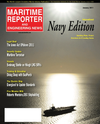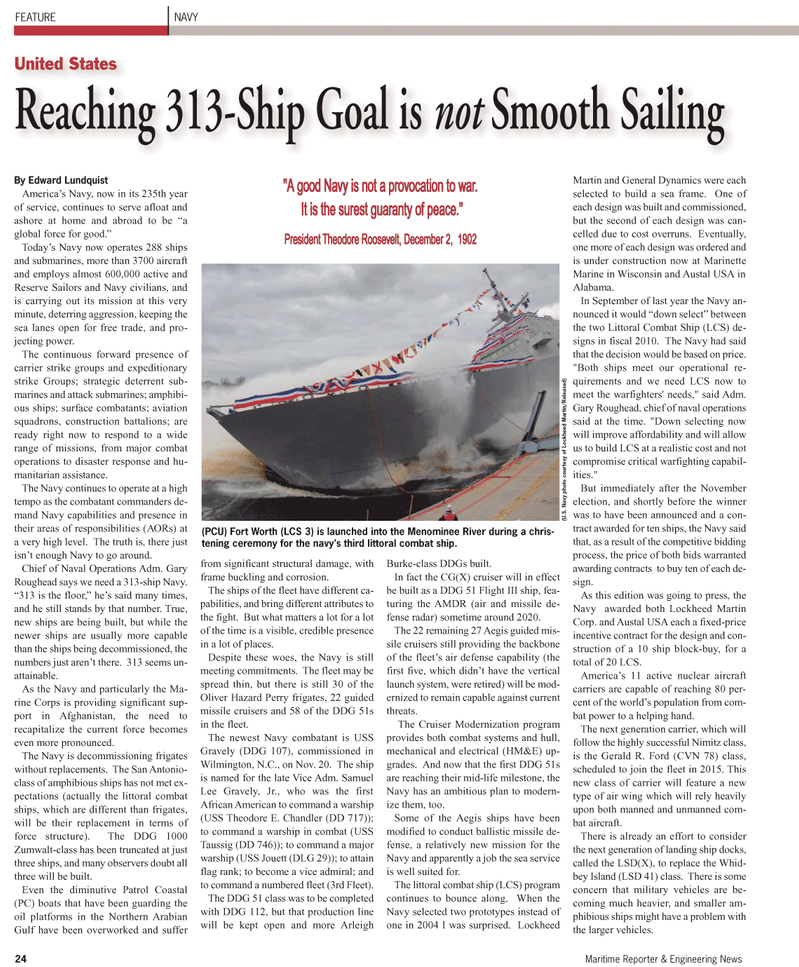
Page 24: of Maritime Reporter Magazine (January 2011)
International Naval Technology
Read this page in Pdf, Flash or Html5 edition of January 2011 Maritime Reporter Magazine
24 Maritime Reporter & Engineering News
By Edward Lundquist
America’s Navy, now in its 235th year of service, continues to serve afloat and ashore at home and abroad to be “a global force for good.”
Today’s Navy now operates 288 ships and submarines, more than 3700 aircraft and employs almost 600,000 active and
Reserve Sailors and Navy civilians, and is carrying out its mission at this very minute, deterring aggression, keeping the sea lanes open for free trade, and pro- jecting power.
The continuous forward presence of carrier strike groups and expeditionary strike Groups; strategic deterrent sub- marines and attack submarines; amphibi- ous ships; surface combatants; aviation squadrons, construction battalions; are ready right now to respond to a wide range of missions, from major combat operations to disaster response and hu- manitarian assistance.
The Navy continues to operate at a high tempo as the combatant commanders de- mand Navy capabilities and presence in their areas of responsibilities (AORs) at a very high level. The truth is, there just isn’t enough Navy to go around.
Chief of Naval Operations Adm. Gary
Roughead says we need a 313-ship Navy. “313 is the floor,” he’s said many times, and he still stands by that number. True, new ships are being built, but while the newer ships are usually more capable than the ships being decommissioned, the numbers just aren’t there. 313 seems un- attainable.
As the Navy and particularly the Ma- rine Corps is providing significant sup- port in Afghanistan, the need to recapitalize the current force becomes even more pronounced.
The Navy is decommissioning frigates without replacements. The San Antonio- class of amphibious ships has not met ex- pectations (actually the littoral combat ships, which are different than frigates, will be their replacement in terms of force structure). The DDG 1000
Zumwalt-class has been truncated at just three ships, and many observers doubt all three will be built.
Even the diminutive Patrol Coastal (PC) boats that have been guarding the oil platforms in the Northern Arabian
Gulf have been overworked and suffer from significant structural damage, with frame buckling and corrosion.
The ships of the fleet have different ca- pabilities, and bring different attributes to the fight. But what matters a lot for a lot of the time is a visible, credible presence in a lot of places.
Despite these woes, the Navy is still meeting commitments. The fleet may be spread thin, but there is still 30 of the
Oliver Hazard Perry frigates, 22 guided missile cruisers and 58 of the DDG 51s in the fleet.
The newest Navy combatant is USS
Gravely (DDG 107), commissioned in
Wilmington, N.C., on Nov. 20. The ship is named for the late Vice Adm. Samuel
Lee Gravely, Jr., who was the first
African American to command a warship (USS Theodore E. Chandler (DD 717)); to command a warship in combat (USS
Taussig (DD 746)); to command a major warship (USS Jouett (DLG 29)); to attain flag rank; to become a vice admiral; and to command a numbered fleet (3rd Fleet).
The DDG 51 class was to be completed with DDG 112, but that production line will be kept open and more Arleigh
Burke-class DDGs built.
In fact the CG(X) cruiser will in effect be built as a DDG 51 Flight III ship, fea- turing the AMDR (air and missile de- fense radar) sometime around 2020.
The 22 remaining 27 Aegis guided mis- sile cruisers still providing the backbone of the fleet’s air defense capability (the first five, which didn’t have the vertical launch system, were retired) will be mod- ernized to remain capable against current threats.
The Cruiser Modernization program provides both combat systems and hull, mechanical and electrical (HM&E) up- grades. And now that the first DDG 51s are reaching their mid-life milestone, the
Navy has an ambitious plan to modern- ize them, too.
Some of the Aegis ships have been modified to conduct ballistic missile de- fense, a relatively new mission for the
Navy and apparently a job the sea service is well suited for.
The littoral combat ship (LCS) program continues to bounce along. When the
Navy selected two prototypes instead of one in 2004 I was surprised. Lockheed
Martin and General Dynamics were each selected to build a sea frame. One of each design was built and commissioned, but the second of each design was can- celled due to cost overruns. Eventually, one more of each design was ordered and is under construction now at Marinette
Marine in Wisconsin and Austal USA in
Alabama.
In September of last year the Navy an- nounced it would “down select” between the two Littoral Combat Ship (LCS) de- signs in fiscal 2010. The Navy had said that the decision would be based on price. "Both ships meet our operational re- quirements and we need LCS now to meet the warfighters' needs," said Adm.
Gary Roughead, chief of naval operations said at the time. "Down selecting now will improve affordability and will allow us to build LCS at a realistic cost and not compromise critical warfighting capabil- ities."
But immediately after the November election, and shortly before the winner was to have been announced and a con- tract awarded for ten ships, the Navy said that, as a result of the competitive bidding process, the price of both bids warranted awarding contracts to buy ten of each de- sign.
As this edition was going to press, the
Navy awarded both Lockheed Martin
Corp. and Austal USA each a fixed-price incentive contract for the design and con- struction of a 10 ship block-buy, for a total of 20 LCS.
America’s 11 active nuclear aircraft carriers are capable of reaching 80 per- cent of the world’s population from com- bat power to a helping hand.
The next generation carrier, which will follow the highly successful Nimitz class, is the Gerald R. Ford (CVN 78) class, scheduled to join the fleet in 2015. This new class of carrier will feature a new type of air wing which will rely heavily upon both manned and unmanned com- bat aircraft.
There is already an effort to consider the next generation of landing ship docks, called the LSD(X), to replace the Whid- bey Island (LSD 41) class. There is some concern that military vehicles are be- coming much heavier, and smaller am- phibious ships might have a problem with the larger vehicles.
FEATURE NAVY
United States
Reaching 313-Ship Goal is not Smooth Sailing (PCU) Fort Worth (LCS 3) is launched into the Menominee River during a chris- tening ceremony for the navy's third littoral combat ship. (U.S. Navy photo cour tesy of Lockheed Mar tin/Released) "A good Navy is not a provocation to war.
It is the surest guaranty of peace."
President Theodore Roosevelt, December 2, 1902

 23
23

 25
25
